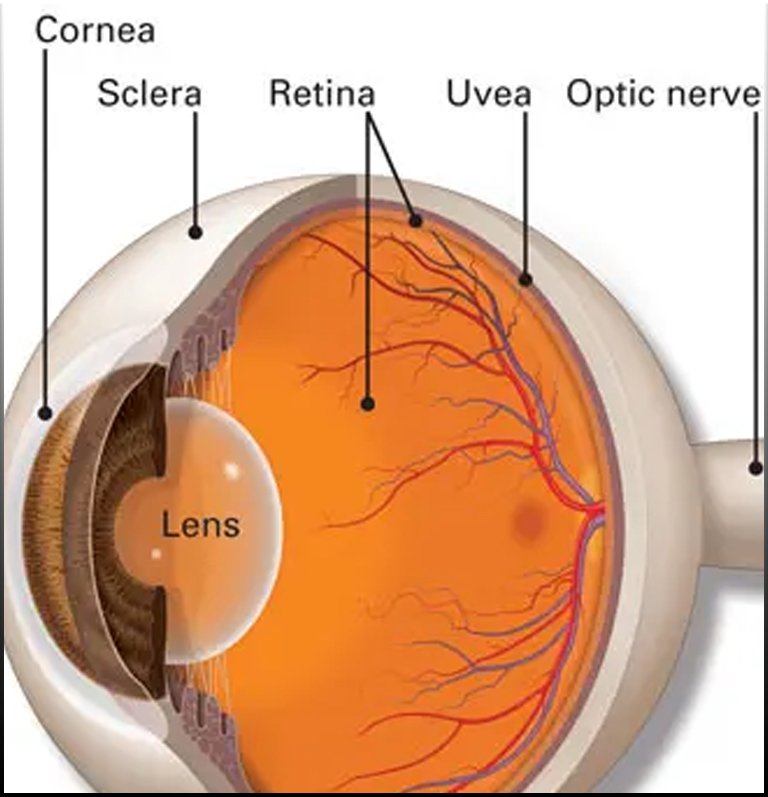


What Is The Retina And Uvea?The retina and uvea are integral components of the eye, playing
distinct yet complementary roles in vision and overall ocular health. The retina, situated
as the innermost layer, serves as a light-sensitive membrane responsible for collecting
visual stimuli.
Its intricate network of cells converts light into electrical signals,
facilitating their transmission to the brain through the optic nerve. Meanwhile, the uvea,
positioned in the middle layer, encompasses the iris, ciliary body, and choroid,
collectively regulating various eye functions.
The iris, with its colorful hues, acts as a dynamic diaphragm, adjusting the amount of light entering the eye and thereby controlling pupil size. The ciliary body contributes to the production and circulation of aqueous humor,
maintaining intraocular pressure and nourishing surrounding structures. Finally, the choroid provides vital nutrients to the retina, ensuring its optimal function.
Uveitis, an inflammation of the uvea, poses significant challenges to ocular health, manifesting in symptoms such as pain, redness, and visual disturbances. Various conditions, including uveitis, choroiditis, and iritis, among others, can affect the uvea, necessitating prompt diagnosis and treatment. Treatment modalities typically involve medications administered through drops or injections, tailored to the specific affected areas and underlying causes. In severe cases, surgical interventions may be warranted to mitigate complications and preserve vision.
Understanding the roles and interactions of the retina and uvea underscores the importance of comprehensive eye care and prompt intervention in managing ocular diseases. However, for personalized medical guidance and diagnosis, consulting a qualified healthcare professional is essential. This information serves as a general overview and should not substitute professional medical advice.

You can protect your eye health and potentially slow the process of cataracts by: Not smoking, Protecting your eyes from the sun, Getting regular eye care, and Wearing sunglasses and a hat with a brim to block ultraviolet sunlight.

Corneal disease, also known as ocular surface disease, is a group of serious conditions that can affect the cornea. These conditions can cause the cornea to become distorted, clouded, or scarred, and can even lead to blindness.

Refractive surgery is an optional eye procedure that improves the eye's refractive state and can reduce or eliminate the need for glasses or contact lenses . It can involve reshaping the cornea, implanting a lens, or replacing the lens.

The retina is the light-sensitive layer at the back of the eye that receives light and converts it into chemical energy. The uvea is the middle layer of the eye between the retina and the sclera (white part of the eye). The uvea is made up of three parts !

Emphasizes fruits, vegetables, whole grains, and fat-free or low-fat milk and milk products.

There are many variations of passages of Lorem Ipsum available, the majority have suffered alteration

There are many variations of passages of Lorem Ipsum available, the majority have suffered alteration
Refractive surgery can correct refractive errors like nearsightedness, farsightedness, astigmatism, or presbyopia. Some of these surgeries reshape the cornea. Others implant a lens in your eye. Either way, the goal is the same. These surgeries focus light correctly on the retina so you can see more clearly.


Pediatric ophthalmology is a subspecialty of ophthalmology that concentrates on treating the various eye problems affecting children. Studies show that a lot of Attention Deficit Hyperactivity Disorder (ADHD) and learning issues in children can be attributed to vision problems.

The retina and uvea are crucial components of the eye, each playing distinct roles in vision. Several factors can lead to issues with these structures.
Genetic Predisposition: Certain genetic mutations or family history can increase the risk of various retinal and uveal disorders, such as retinitis pigmentosa or uveitis.
Age-Related Degeneration: Aging can contribute to conditions like age-related macular degeneration (AMD) or posterior uveitis, where the structures deteriorate over time, leading to vision loss.
Trauma:Physical trauma to the eye can damage the retina or uvea, causing conditions such as retinal detachment or traumatic uveitis.
Infections:Bacterial, viral, or fungal infections can affect the retina (e.g., cytomegalovirus retinitis) or the uvea (e.g., toxoplasmosis), leading to inflammation and potential vision impairment.
Autoimmune Disorders: Conditions like autoimmune uveitis involve the immune system mistakenly attacking the eye's tissues, leading to inflammation and damage.
Systemic Diseases: Diseases such as diabetes can impact the retina, causing diabetic retinopathy, while systemic conditions like sarcoidosis can affect the uvea, leading to sarcoid uveitis.
Hypertension and Vascular Diseases: High blood pressure and other vascular diseases can affect the blood vessels in the retina, leading to conditions like hypertensive retinopathy or central retinal vein occlusion.
Environmental Factors: Exposure to harmful substances or radiation can damage the retina or uvea, contributing to conditions like solar retinopathy or radiation retinopathy.
Medication Side Effects: Certain medications, particularly those used in chemotherapy or to
suppress the immune system, can have adverse effects on the retina or uvea.
Nutritional Deficiencies: Inadequate intake of essential nutrients, such as vitamin A, can
impact
retinal health, leading to conditions like night blindness or xerophthalmia.
Understanding the underlying causes of retinal and uveal disorders is essential for timely diagnosis and appropriate management to preserve vision and prevent further complications. Regular eye exams and prompt medical attention for any visual symptoms are crucial in maintaining eye health.